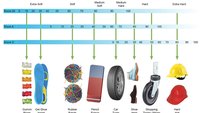
Rock Shox Revelation Review
2010 Rock Shox Revelation Dual Air Motion Control
The Revelation was mounted for most of its life to a Santa Cruz Blur LT and to a SC Nomad for the pictures in this review. It replaced a 2009 Fox Talas 150mm for the duration of the test. Throughout 2010, the bike saw mainly trail-riding duties in the Vancouver to Pemberton area, with some cross-country races thrown into the mix on the week-ends. For the most part I have a hard time turning down a little added spice to my trail rides: the Revelation tagged along and was ridden through its fair share of ‘not so dandy’ terrain as a result.

Damping, chassis and other pre-ride notes
Out of the box the Revelation’s Motion Control is not the most intuitive damper to adjust.
Briefly, the Gate serves two purposes:
– Functions as a high-speed compression adjuster
– Dictates the range of adjustment of the low-speed compression adjuster. The more “Gate” used, the closer to a lock-out the compression adjuster becomes at it is moved clockwise through its range.
Once this is assimilated the adjustments are easily made on the trail, thanks to the decently positive feeling adjusters located comfortably within reach on the right-side top cap of the fork. Preference for a firmer feeling front end had me run the Gate 13 clicks clockwise (19 clicks total) and compression three clicks clockwise (six clicks total).

In this case, I found the air spring pressure recommendations to be on the low side, most notably when the fork was running smoothly. RockShox recommends about 120 psi in both the negative and positive chambers for a 180 pound rider. At 175 pounds, I ended up with 140 psi in both chambers to achieve the desired 21% sag. At this high pressure, the feel of the fork was not compromised and no ill effects appeared long-term.

The rebound adjuster on this particular fork has not swayed from its call of duty and has held on tight to the foot nut. Most RockShox forks I have seen have lost the red rebound adjuster knob not long after being mounted. I consider myself lucky with this fork and do recommend removing the knob and storing it in your pack.
It seems like both RockShox and Fox are on top of their game and funky axle-to-crown heights are a thing of the past. The 140mm Revelation is not an exception to the rule and nicely complimented the geometry of the LT.
Weight was comparable to the 2009 Fox Talas 150 (15mm QR, 1 1/8th steerer), yet the Revelation’s chassis did have less give.
The Maxle Light is simple to use and serves its function well. Reliability has been decent, as the assembly has required occasional cleaning not to seize.

Riding time
The Revelation is a hard fork to fault on the trail. Good small bump sensitivity, a controlled mid and end-stroke. No surprises here. RockShox has perfected the Motion Control damping and it does its job well in all encountered situations. In steeper terrain, where heavier impacts are common, the compression adjuster was easily used to add necessary support to the front end. Compliance is not greatly affected and this feature is appreciated given the variety of terrain encountered locally.
The Revelation’s compliance is a strong point: even with a firmer set-up, small bump sensitivity is not a concern. Small asperities are filtered and little feedback is passed on to the rider. The Revelation’s damping does not offer the same mid-stroke control as the Fox and as such I increased air pressure and damping over the duration of the test to compensate.

The chassis’ increased rigidity over the Fox was noticeable. At 175 pounds, this characteristic is not something I would pinpoint as a positive or negative trait of either the RockShox or Fox product. Neither exhibited extremes in this department: the greater give of the Fox did not force me to maintain a higher level of focus in demanding terrain, nor did the Revelation’s rigidity cause unwanted deflection or an excessive amount of feedback. Both forks had the necessary give to “dance” in rough terrain, one having more than the other. For heavier riders, or those demanding quite a bit more from their shorter-travel trail forks, this might become an issue.
Encountered issue:
The Dual Air spring assembly has needed constant adjustment. Positive and negative air spring pressures have to be reset at least weekly to bring the fork back to its stock height. The fork creeps down in its travel otherwise. The problem will occur less often if positive and negative air pressures are kept identical. Even if identical air pressures are used, both chambers will still have to be reset multiple times monthly. RockShox is aware of the issue, and changes have been made to 2011 Dual Air assemblies. I cannot confirm that the problem has been remedied in the next generation Dual Air. (But we’ll know soon once the 2011 fork review gets in our hands – hopefully soon! – Ed.)

Overall
It is hard to ignore the Dual Air flaw of the 2010 generation of the Revelation. Yet with its excellent trail manners, affordable maintenance costs and a competitive MSRP of $879, the overall package value of the Revelation Dual Air MC is obvious.
Is there a bike in your quiver that could benefit from a fork like the Revelation? We’ll be posting a review of the 2011 product soon. Until then give us your thoughts here…







Comments
Please log in to leave a comment.